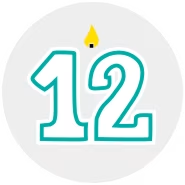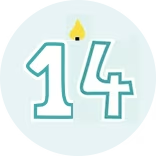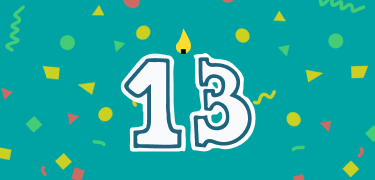Your 13-Month-Old’s Development and Milestones
Your not-so-little one is on the go these days, which means they might be crawling, cruising, or even taking those first thrilling steps. In the coming months, your child may begin to test their boundaries by expressing what they want in a more straightforward way. This growing independence and emerging personality will be exciting for you, and—at times—a little challenging. It can be hard work entertaining a toddler! Learn more about your 13-month-old’s development milestones, including food discoveries and appetite swings, the type of sleep schedule that works best for your toddler, and much more.
Toddler Development Milestones
Every toddler is unique, developing in their own way and on their own timeline, so these milestones aren’t set in stone. Instead, these are the kinds of things you might begin to see at 13 months, although it’s possible you might start seeing them a little earlier or later:
Slower growth. Compared to the rapid growth of the first 12 months, your little one’s growth will now start to slow. So, how much “should” a 13-month-old weigh? Your toddler will probably put on only about three to five pounds in the coming year. Your toddler’s healthcare provider will continue to monitor your child's growth using growth charts during regular checkups.
Toddling. As the name “toddler” suggests, your little one will likely start toddling soon, if they haven’t already taken those first few steps. Learning to walk doesn’t happen all at once, so be prepared for lots of stops and starts and falls. Even things like a change in surface or direction may cause a child to lose balance and drop to the ground. In time, they’ll become more skilled and confident. It usually takes a month or two to go from those tentative early steps to your toddler being able to stand and move independently without you there for support.
Although there’s lots of change going on, one thing is for sure: You’ll get rewarded for buying Pampers diapers when you have the Pampers Rewards app.
Activities for Supporting Your 13-Month-Old Toddler’s Development
If you’re wondering what a 13-month-old “should” be doing, what to do with your toddler, or what you “should” be teaching them, check out the following activities and ideas for supporting your 13-month-old’s development:
Read together every day. Spending a few minutes reading to your little one—whether at bedtime or earlier in the day—can be a cherished part of your family life as well as a great learning opportunity. As you look at the pictures together, name the objects or animals they’re pointing to, and help them turn the page. Around this month your little one may be able to pick a book to read and mimic the sounds animals make after you’ve demonstrated a few times.
Choose toys that help foster hand-eye coordination and fine motor skills. Give your 13-month-old things like big blocks and soft toys to play with. They’ll enjoy getting better at picking up objects with their thumb and forefinger and holding onto them.
Have conversations with your little one. Your 13-month-old may not be talking much yet, but that doesn’t mean you can’t have “conversations” that aid in language development. Diaper changes, bath time, strolls in the park, and drives can be great opportunities to “narrate your day,” talking with your little one about what you’re doing and what’s happening in the world around them. Feel free to use your “adult voice” now.
Wean off the bottle (if you haven’t already). If your child still uses a bottle, it’s time to transition to a cup. Experts recommend completing the switch from the bottle to cup by 18 months. A good way to start is by gradually removing the midday bottle, then the morning and afternoon one, and finally the bedtime bottle.
Mealtimes and Menus for Your 13-Month-Old
Your child is still getting the hang of feeding themselves, either with a spoon or their fingers, and drinking from a cup. Mealtime messes and spills are part of the learning process, and sometimes part of the fun for your toddler.
You may notice that your toddler seems to be less hungry than before. So, how many calories “should” a 13-month-old eat? Although growth rates, metabolism, and activity levels vary from child to child, 13-month-olds need roughly 1,000 calories per day. These can come from three small meals and two snacks.
That’s not as much food as you might think, though; 16 ounces of whole milk could account for about 300 of those daily calories, for example.
You may also notice that:
Your child may consume close to 1,000 calories one day but eat much more or much less the following day
They may want a huge breakfast but then not be hungry the rest of the day
They may gobble up a favorite food but then reject that same food a few days later.
Still curious about how much a 13-month-old “should” eat? Instead of worrying about the amount, focus on offering a variety of nutritious foods from the main food groups: proteins like meat and eggs; dairy products like milk, yogurt, and cheese; fruits; vegetables; and whole-grain foods such as cereals, pasta, and breads.
Don’t stress about what to feed your 13-month-old or how to achieve a balanced diet at every mealtime. If you offer healthy options for meals and snacks, your little one will eat what their body needs to ensure they get the right balance of nutrients over the course of a few days.
The key is to experiment with different tastes and consistencies, offer lots of nutritious options, and let your little one choose how much and what to eat. For more inspiration, check out these tips on feeding a 12- to 18-month-old.
Introducing Cow’s Milk
Now that your little one is 13 months old, cow’s milk should be a regular part of their diet. So, how much milk “should” they drink? You can offer up to 16 ounces of whole milk or 2 percent milk. Consult your toddler’s healthcare provider if you’re unsure which kind is best for your child. Be sure you’re giving the milk in a cup or a sippy cup rather than in a bottle.
With cow’s milk now on the menu (as well as a greater range of solid foods) you might notice changes in poop. This is normal, but if your little one gets diarrhea or becomes constipated, or you’re worried about the contents of their diapers for any reason at all, contact your toddler’s healthcare provider.
Here is a sample daily menu/feeding schedule for your 13-month-old:
Your 13-Month-Old’s Sleep Schedule
So, how much sleep does a 13-month-old need? In total, your toddler probably needs about 12 to 14 hours of sleep a day.
And how many naps “should” they take? Your 13-month-old may still need two daytime naps at this stage, but around half of all toddlers are down to one nap a day by 15 months. The transition to a single nap will probably happen gradually over the coming months. You might find that the morning nap will be the first nap to go because your toddler no longer needs it.
There’s no one-size-fits-all approach when it comes to a 13-month-old’s sleep schedule. Experts recommend watching your little one for signs of tiredness—like crabbiness—and adjusting their sleep schedule to match.
To help you track your 13-month-old’s nap and sleep schedule, download the Smart Sleep Coach app by Pampers. Cocreated by pediatricians and sleep experts, this easy-to-use app can come in handy when difficulties like sleep regression arise.
A Day in the Life of Your 13-Month-Old Toddler
Now that you have a toddler on your hands, here’s what a day in your home might look like:
Your Toddler’s Health: Establishing a Healthy Lifestyle Early
As your toddler eats a greater variety of foods and starts to exert a little more control over their activities and choices, it’s a great idea to establish healthy habits nice and early. Here are just some of the ways you can begin to do this, even now:
Give your little one lots of opportunities to be physically active
Pay attention to your child’s cues that they’re full, and don’t urge them to eat when
they’re not hungry
Instead of giving sugary snacks, give your toddler healthy snacks like fruit, whole-grain crackers, vegetables, and low-fat dairy foods
Avoid screen time and digital media until your child is between 18 and 24 months old.
Set a good example by eating nutritious, healthy foods yourself and staying physically active
Avoid using food as a reward. Instead, reinforce good behavior by telling your little one they’ve done a great job or by giving them hugs and kisses.
Development Tips for Your Toddler This Month
Consider the following ideas and bonding tips to help encourage your 13-month-old toddler’s development:
Be attentive to your toddler’s moods and behavior. Every child is different and has their own unique rhythm. Be supportive of your toddler’s needs and use praise and attention to reward good behavior.
Establish everyday routines. Most children do well when mealtimes, naptimes, and bedtime occur at predictable times every day. Do you best to keep your 13-month-old’s daily schedule consistent.
Play with your child every day. Whether that means taking your little one to the park or simply playing on the living room floor, be sure to spend time together having fun.
Talk to your toddler. By now, it’s a good idea to have switched from baby talk to adult talk. Communicate with your child as you make your way through the day’s activities. Speak slowly, give your child an opportunity to respond to questions, and when your child injects a word, repeat it and add on to the conversation. For example, if you hear your toddler say “milk” as you're pouring a cupful, you might respond by saying “Yes, it’s milk. Would you like some?”
Prioritize safety. Since your toddler is much more active, they’re bound to get into some things you might not want them getting into. Set some firm, simple rules to keep your child safe, such as not touching the stove because it's hot.
Items You Will Need This Month
Here’s a list of baby gear items you might like to plan on purchasing this month if you haven’t already:
Baby gates. Whether you have a multilevel home or simply need to keep a few rooms off limits from your little one, baby gates will come in handy.
Sippy cup. At 13 months old, your child should be drinking from a cup or sippy cup. If you’d like to start them on a sippy cup, look for one that’s easy to hold and easy to clean.
Toddler car seat. If your toddler has outgrown their infant car seat, it may be time to switch to a convertible car seat, which should be installed rear-facing in the car's backseat. Make sure to check the manufacturer’s guidelines for height and weight limits.
Children’s toys. By 13 months old, your child may have lost interest in some of their baby toys. Look for new, age-appropriate toys that can help boost their development.
Diapers, wipes, and diaper rash cream. Don’t forget to replenish your stock of diapers and wipes and keep that diaper rash cream handy just in case.
Children’s books. Reading is a bonding and educational activity you’ll want to continue doing with your little one no matter how old they get. Choose some of your favorite books from your childhood or add some new titles.
FAQS AT A GLANCE
There’s no definitive answer, as language development varies greatly from child to child. At 13 months, some toddlers may be able to say a few simple words like “mama” and “bye-bye.” If you’re concerned that your 13-month-old is not talking yet, consult your toddler’s healthcare provider.
Your Life as a Parent: Being Ever Vigilant
Your 13-month-old is increasingly independent and curious about the world but will not yet be able to understand your instructions about what is right and wrong. This means a big part of your role is being vigilant to ensure that your little one stays safe.
For example, if your 13-month-old picks up a breakable object, they won’t yet be able to follow your instructions to put it down gently. Instead, you’ll have to take the object away, place it out of reach, and quickly substitute a safe object for your child to play with instead.
Aside from being vigilant, being able to think on your feet and redirect your toddler’s attention to safe objects will be a skill you will master during the coming years.
Childproofing your home so that your child can safely explore certain areas of your home will encourage their mobility and independence while also giving you peace of mind.
For example, putting safety guards on electrical outlets, adding corner guards to the coffee table, securing furniture, and blocking stairs and doorways with baby gates are all things you can do to make the living room a safe space for your 13-month-old to explore and practice walking in.
Being so watchful and anticipating your 13-month-old’s next move may be tiring for you as a parent. Remind yourself that ensuring your toddler is safe while also getting a chance to learn about the world is important for happy and healthy development.
Checklist for This Month
□ Childproof the backyard. As your little one will want to start playing outdoors more and more in the coming years, now is a great time to childproof the backyard. Make sure you have a fence that barricades access to the driveway or street. If you have play equipment, make sure there is something soft to fall on, like sand or mulch, underneath. If you have a pool, it should be completely fenced off from the rest of the yard. Double check that the pool fence meets the latest safety standards, too, and that your toddler has no way to access the pool when you’re not watching.
□ Check on immunizations. Sometime between 12 and 15 months, your little one will need booster vaccine doses as well as some first doses of certain vaccines to keep them healthy and safe. These shots are often given at the regular 12-month or 15-month well-child visits. Check with your child’s healthcare provider to make sure your toddler stays up to date with their immunization schedule.
□ Review the guidelines for items like the car seat, stroller, and crib. Car seats and strollers have size and weight limitations, and the crib mattress needs to lowered as your child grows to ensure they can’t crawl out of the crib. Now is a great time to recheck these guidelines. In some cases, you may need to upgrade some of the baby gear you have, or simply change a setting to make room for your toddler’s growth.
□ For even more information, sign up to get our regular emails:
How We Wrote This Article The information in this article is based on the expert advice found in trusted medical and government sources, such as the American Academy of Pediatrics and the American College of Obstetricians and Gynecologists. You can find a full list of sources used for this article below. The content on this page should not replace professional medical advice. Always consult medical professionals for full diagnosis and treatment.



